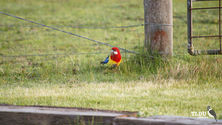
Shoppers Feedback:
Jan 17, 2017
Hello Ros,
I have now paid the invoice, but I would like to write to you just to say a big THANK YOU for getting me the Penguin!
The ChatterMate Penguin became a nice memory for me when I was in New Zealand, and I am so greatful to you for arranging so that I could have it! :-)
Thank you so much!!!!!!!!!!!
Regards,
Malin
Hi Ros,
Many thanks for your very kind email. I really appreciate your prompt reply!
I appreciate your advice regarding the decorations and customs. These are a gift for my daughter’s exchange student family so when she returns home on the weekend I will show her and see if she loves them as much as I do!
Thanks so very much again - I am truly grateful for your kind assistance.
Kind Regards
Bernadette
Ros,
Thanks again for the great customer service. It's a refreshing change!
Best regards,
Trevor
Hey Roz,
Thank you for your emails. Just loved my first order. The cute little Aussie bush critters are going to be used for an office Christmas decoration. My colleagues also liked them and talked about making an order to your site. I'll send you a photo when completed.
I'll be ordering more to send to my daughter's host family in America.
Fabulous service from you.
Kind regards,
Michelle
Thankyou. Order arrived today. One very happy grandson with his new beastly binoculars.
Regards,
Irene
- Home
- Wild Wonders
- Shop
- Aromas of Australia
- Australian Made
- Books
- Book Marks
- Christmas Decoration Sale
- Christmas Decorations
- Clocks
- Drink Holders
- Garden & Outdoor
- Gift Wrapping & Cards
- Home & Giftware
- Jewellery
- Keyrings
- New Products
- Pencils & Pen Holders
- Photo Frames
- Plush Toys
- Plush with Sound
- Sheepskin Rugs
- Stationery
- Stone Carvings
- Toys & Games
- Travel Goods
- Wedding
- Wild Figurines
- Wildlife Safety Products
- Wind Chimes
- Wine Charms
- View All Products
- Wildlife
- Australiana
- Explore
- Contact Us

Quick Facts
| Length: | 30 cm |
| Height: | - |
| Weight: | 99 grams |
| Colour: | Varied |
| Habitat: | Open woodlands, grasslands, farmlands and remnant bushland. Often found in urban parks, garden and g |
| Food: | Seeds, fruits, buds, flowers, nectar and insects |
| Predators: | - |
| Status: | Not Present in WA & NT. Secure in all other states and territories in Australia |
Eastern Rosellas are medium-sized colourful parrots with distinctive white cheek patches. It has a red head, neck and breast, with yellowish to greenish upper parts, a yellow underbody and a yellow-green to blue-green rump, with a red undertail. The shoulders are bright blue. Females are usually similar to males, but sometimes duller and young birds are even duller and can be aged by their bill colour, which is yellow or orange, changing to off-white when mature.
The Eastern Rosella can be distinguished by its red head combined with white cheek patches. The similarly sized Pale-headed Rosella Platycercus adscitus has white cheek patches but has a pale yellow head.
The Eastern Rosella is found throughout south-eastern Australia, from Queensland to Victoria and south-eastern South Australia. Also found in eastern Tasmania. Has been introduced to New Zealand.
The Eastern Rosella is found in open woodlands, grasslands, farmlands and remnant bushland. Often found in urban habitats such as parks, gardens and golf courses.
The Eastern Rosella mainly feeds on the ground, especially amongst grasses in lawns, pastures and other clearings. Also feeds in trees and bushes. Main dietary items include: seeds, fruits, buds, flowers, nectar and insects.
The Eastern Rosella uses one of its feet (usually the right foot) to hold food when eating on the ground or perched on a tree.
Eastern Rosellas mate for life. The female chooses and prepares the nesting site, usually a hollow in a eucalypt tree (but will sometimes use a nest-box or other artificial site). Eggs are laid on a decayed wood bed and the female incubates the eggs while the male regularly feeds her. The young may be fed for a while after they fledge.
Eastern Rosellas may damage fruit and other crops, and have been trapped for the aviculture trade in large numbers. Compete with introduced birds, e.g. Common Starlings, for suitable nest hollows, and are sometimes caught by domestic pets.
Last Updated: Thursday 18th July, 2013
BirdLife Australia - www.birdlife.org.au
BUSH e-TELEGRAPH
Signup for our monthly newsletter the "e-Telegraph"
Quick Links
Home | The Beginning | About The Land Down Under | Wild Wonders | Advertise on Wild Wonders | Christmas Decoration Sale | Christmas Tree Decorations | Drink Holders | Plush with Sound | Stone Carvings | Wildlife Wine Charms | Freebies | Australian Wildlife | Help Our Wildlife | Australiana | Photo of the Month | Explore The Land Down Under | Contact Us | Legal Notices

